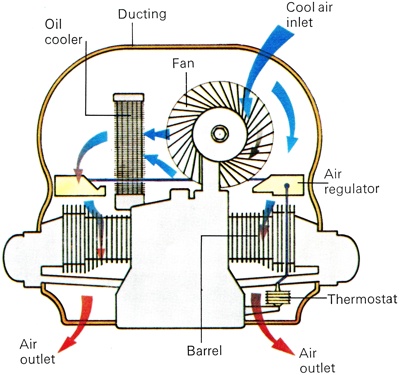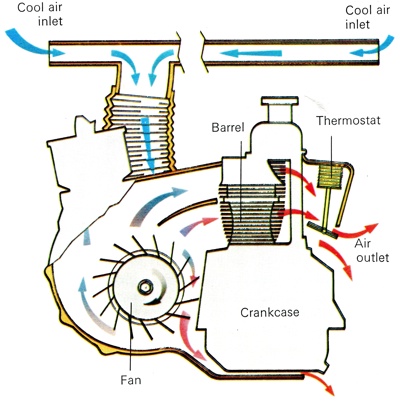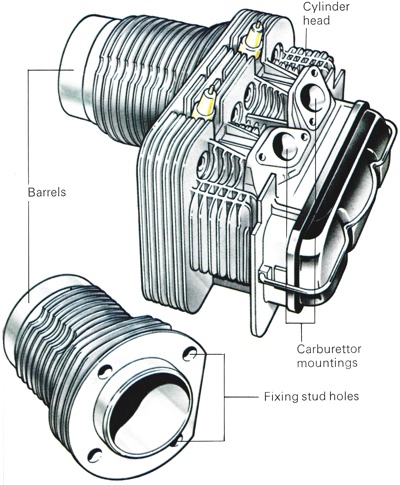All car engines produce a great deal of heat during the combustion process. This heat has to be removed from the engine to prevent permanent damage. So engines cannot function without some form of
cooling system. Water-cooling is the most common method, though for many years several European manufacturers have produced successful air-cooled engines. Air-cooled engines powered the Volkswagen "Beetle" and 411, some cars in the Citroen range and the Fiat 126 and 500. Several other European makes - some
DAF models,
Panhards,
NSUs and the Czechoslovakian
Tatra all employed air-cooling as did GM with the
Corvair. The only manufacturer of high-performance air-cooled cars has been
Porsche, with its
911, 911SC and Turbo models.
Pros and Cons of Air-Cooling
The great advantage of air-cooling is its simplicity; that is why it was used extensively in motor cycles, stationary pumps and petrol-engined road tools. Air-cooling can be applied to low-capacity, low-powered engines where price is the most important factor. The fact that an air-cooled engine needs no radiator, water jacket or water pump or many of the other components associated with water-cooling means that the manufacturing costs and, therefore, car prices can be kept low. The
Citroen 2CV, for example, was originally designed during the depression of the 1930s, with the intention of producing the cheapest, simplest possible car. Similar priorities were behind the
Volkswagen Beetle designed at about the same time as a "people's car" by
Ferdinand Porsche.
The "
Beetle", after it went into production following World War 2, went on to become the most successful volume-production economy car ever made. Air-cooled engines were not only simple; they were also light. The extensive use of alloy rather than steel in their construction and the absence of many of the water-cooling components allowed the engine designer to save a great deal of weight. The Citroen 2CV6 engine, for example, weighed only 35 kg (771bs) and the average air-cooled engine weighed 13 kg (301bs) per litre less than the water-cooled equivalent.

The cooling system used on the most known air-cooled engine, the VW Beetle. Air is drawn into the ducting by the fan and passes through an oil-cooler before flowing over the cylinder heads and barrels.

Another air-cooled engine design, this from the Fiat 126 and Fiat 500 engines. The air is sucked into the engine compartment through a tunnel that runs beneath the rear shelf. It then flows round the barrels and under the crankcase.

A pair of cylinder heads from a VW flat-four engine. The heat of the combustion chamber explains the use of deeper fins on the cylinder head than on the barrels. |
The Horizontally Opposed Air Cooled Engine
Air-cooled engines are normally made in a horizontally opposed or wide "V" configuration. In small engines this is no problem; in fact designers used it to their advantage by making the engine compact and so producing cars of small overall size with a comparatively spacious interior. In many rear-engined, air-cooled,
Volkswagen cars and light commercial vehicles the engine was "hidden" under the floor bringing consequent benefits in case of loading and in bulk load capacity. Ease of maintenance was also often quoted as a point in the air-cooled engine's favour. From an early stage of development, the arrangement of totally separate cylinders was used on most of these engines, to allow air to flow right round each cylinder.
This also meant that separate cylinders could be quickly removed from the engine, to gain access to the piston and con-rod. Although air-cooling was most widely used on small, inexpensive engines this did not imply that air-cooling is inefficient. There was no reason why an air-cooled engine was less efficient than a water-cooled design, but it did have some drawbacks. The two great disadvantages of the air-cooled engine were noise and the problems of applying air-cooling to large multi-cylinder engines. The noise problem was caused by two factors - the absence of a water jacket and the noise of the cooling fan. As there was less material round the engine block, the sounds of combustion were less muffled. The operation of the cooling fan, which forces air over the engine, also created a considerable amount of noise.
Components of Air-Cooled Engines
The components of most air-cooling systems are quite simple. The cooling fan is positioned in a semicircular ducting. The ducting also covers the cylinder head and its interior is fitted with baffles which channel the flow of air over the engine cooling fins and through an oil cooler. Below the cylinders the air is directed over a thermostat, which operates a valve via a lever. The valve controls the amount of air reaching the fan, thus maintaining the correct engine temperature. After passing over the engine and thermostat, the air is forced out of the rear of the car or passed through a heat transfer system that supplies hot water to the car's heater.
One problem associated with the use of air-cooled engines is the provision of an adequate heating and demisting system for the car. Water-cooled engines always have a constant supply of hot water and it is easy enough to convert this into hot air. Air-cooled engines usually have an independent heater or harness the heat of the exhaust system. Some older models have heating systems that combine both of these methods. An electrically-operated heater which burns petrol supplied hot air to the car interior by way of a blower fan. The same fan fed the hot air from the heat exchangers, which were finned alloy castings on the exhaust system. Hot air was fed into a mixer chamber, where it was blended with fresh air to give a controlled amount of heat.
Principles of Air-Cooling the Engine
The cylinder head and cylinders or "barrels" to use the motor cycle term, of an air-cooled engine are cast with fins. These fins spread the heat of the engine over a wide area. If a barrel is made without fins and is 15 cm (6in.) long, all its heat will be spread over that length. If the barrel is manufactured with 10 fins, each 5 cm (2in.) deep the same amount of heat will be dispersed over 100 cm (40in.). This will lower the overall barrel temperature and permit the air greater access to surfaces that most require cooling. The engine-driven fan directs a blast of cool air on to the fins. The fan is necessary because an air-cooled engine requires a very large airflow: 4,000 times more air than water, by volume, is needed to cool an engine, so the flow of air created by the car cannot be relied upon.
Design Needs of an Air Cooled Engine
Shape and size of both fins and fan are crucial to the engine's efficiency; so is the spacing of the fins. Wide spacing of the fins will give an easy air flow and therefore impose only a small load on the fan, which can thus be quite small. Closer spacing of the fins will extract more heat, but will also demand a more powerful fan to maintain the cooling process, which in turn will absorb more of the engine's power.
A compromise has to be found which will also take into account the noise generated by a large fan and the passage of air past the fins. It must not be thought that designing the fins is simply a matter of ensuring that the engine does not overheat. If the fins are too effective the engine will operate at too low a temperature. This will reduce its thermal efficiency, that is, the proportion of power which the engine extracts from the fuel's potential, thus lowering power output and raising fuel consumption.
The size of the fins is therefore carefully calculated to ensure that the engine runs at an efficient working temperature. The shape of the fins is just as important as their size. In theory the ideal cooling fin has slightly concave sides, ending in a sharp point. This design gives maximum heat dissipation, but in practice this type of fin is weak and easily broken. A better, more practical form has straight sides meeting in a point, but it still carries a risk of damage and is, in any case, rather difficult and therefore expensive to manufacture.
The usual compromise is to design fins with straight sides and a rounded outer tip. To be effective, the fins must have some degree of taper and a reasonably sharp tip. Blunt parallel-sided fins tend to retain heat, so they are rarely used, despite their simplicity and strength. The ducting that channels the air around the engine must also be carefully designed. The VW "Beetle" has a series of carefully placed baffles which direct the air to the hottest part of the engine.
The most difficult part of the engine to keep cool is the cylinder head, because the combustion chamber, valves and piston crown are subjected to the full temperature of the burning charge of fuel. The problem of coping with these very high temperatures is increased by the fact that the carbon which builds up on these parts is a very poor conductor of heat. The finning on air-cooled cylinder heads is therefore always very deep, to provide the maximum area for heat dissipation. Another problem is that the temperature of an air-cooled engine changes much more quickly than that of a water-cooled one. Water-cooling transmits the changes in temperature gradually. The basic construction of an air-cooled engine must therefore be designed to cope with rapid changes in temperature.
This means that the differing expansion rates of aluminium, steel and cast iron have to be considered, to ensure that running tolerances will be maintained. Torque loadings on vital bolts and screws are also critical: if they are too tight the rapid expansion of the engine as it warms up could either strip the threads or fracture an important component. The torque setting for the cylinder head nuts on the VW "Beetle", for example, is only 32 Nm (231b ft) - less than half the recommended setting for many water-cooled engines of similar capacity.
High Performance Air-Cooled Engines
Air-cooling creates a problem when an engine is designed from the outset for maximum performance. Four cylinder engines cannot be used for much over two litres capacity. Above this a six or eight cylinder engine is generally employed. Yet a six or eight cylinder air-cooled engine has a large area of finning to be cooled and it is a difficult task to achieve an even distribution of air to all the cylinders and cylinder heads. Other problems arise with an air-cooled eight cylinder engine. Because it is important to channel air right round each barrel, the cylinders must be spaced at wide intervals. A distance between the centres of the cylinders of 1.5 times the bore diameter is the usual minimum ratio. This is far wider than the same dimension on the water-cooled counterpart and it obviously adds to the overall length of the engine, usually by about 20 cm (8ins.) in the case of a three litre engine.
Powerful air-cooled engines also produce problems for the chassis designer and stylist. The engine is very shallow and broad and this can be difficult to assimilate into a car of conventional layout and appearance. Porsche cars have mastered the problems of large air-cooled engines. All the 911 cars have a six cylinder engine of three litres, mounted at the rear of the car. In 1969 Porsche introduced the 917 sports racing car which was powered by a flat-12 engine of five litres capacity. This air-cooled car was one of the fastest racing sports cars timed at more than 370 km h (230mph). Honda Motors is another Company to have produced a powerful air-cooled engine. This was used briefly in a Formula One car in 1968. Powerful air-cooled engines have been used in aircraft, where there is no cooling problem because the cylinders can be arranged radially and mounted in the air flow.



